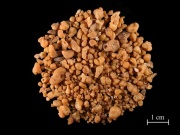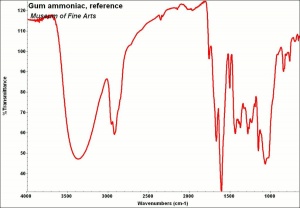Difference between revisions of "Ammoniac gum"
(username removed) |
(username removed) |
||
| Line 2: | Line 2: | ||
== Description == | == Description == | ||
| − | A complex gum/oil/resin mixture obtained from the stems of carrot family plant, ''Dorema ammoniacum'', native to Iran and India. Ammoniac is a strong smelling exudate that dries to form hard, brittle, dark yellow lumps. It contains approximately 50-70% resin, 18-26% gum and 1-7% oil. Ammoniac is typically prepared for use either as a water emulsion or as a mixture with [http://cameo.mfa.org/materials/fullrecord.asp?name=mastic | + | A complex gum/oil/resin mixture obtained from the stems of carrot family plant, ''Dorema ammoniacum'', native to Iran and India. Ammoniac is a strong smelling exudate that dries to form hard, brittle, dark yellow lumps. It contains approximately 50-70% resin, 18-26% gum and 1-7% oil. Ammoniac is typically prepared for use either as a water emulsion or as a mixture with [http://cameo.mfa.org/materials/fullrecord.asp?name=mastic%20resin mastic] and [http://cameo.mfa.org/materials/fullrecord.asp?name=isinglass isinglass]. This makes a strong cement that is used to adhere [http://cameo.mfa.org/materials/fullrecord.asp?name=gilt gilding], set [http://cameo.mfa.org/materials/fullrecord.asp?name=gemstone gemstones], and repair [http://cameo.mfa.org/materials/fullrecord.asp?name=porcelain porcelain]. Ammoniac is also used in perfumes and medicine. |
[[File:ammoniac_gum.jpg|thumb|Ammoniac Gum]] | [[File:ammoniac_gum.jpg|thumb|Ammoniac Gum]] | ||
| Line 34: | Line 34: | ||
== Authority == | == Authority == | ||
| − | * | + | * G.S.Brady, ''Materials Handbook'', McGraw-Hill Book Co., New York, 1971 Comment: p. 664 |
* ''The Merck Index'', Martha Windholz (ed.), Merck Research Labs, Rahway NJ, 10th edition, 1983 Comment: entry 518 | * ''The Merck Index'', Martha Windholz (ed.), Merck Research Labs, Rahway NJ, 10th edition, 1983 Comment: entry 518 | ||
| − | * | + | * Website address 1 Comment: "How to Prepare and Gild with Gum Ammoniac" by Peter Lynn www.geocities.com/CollegePark/Library/2036/gumammon.html |
| − | * | + | * George Savage, ''Art and Antique Restorer's Handbook'', Rockliff Publishing Corp, London, 1954 |
* Art and Architecture Thesaurus Online, http://www.getty.edu/research/tools/vocabulary/aat/, J. Paul Getty Trust, Los Angeles, 2000 | * Art and Architecture Thesaurus Online, http://www.getty.edu/research/tools/vocabulary/aat/, J. Paul Getty Trust, Los Angeles, 2000 | ||
Revision as of 07:46, 24 July 2013
Description
A complex gum/oil/resin mixture obtained from the stems of carrot family plant, Dorema ammoniacum, native to Iran and India. Ammoniac is a strong smelling exudate that dries to form hard, brittle, dark yellow lumps. It contains approximately 50-70% resin, 18-26% gum and 1-7% oil. Ammoniac is typically prepared for use either as a water emulsion or as a mixture with mastic and isinglass. This makes a strong cement that is used to adhere gilding, set gemstones, and repair porcelain. Ammoniac is also used in perfumes and medicine.
Synonyms and Related Terms
Dorema ammoniacum; gum ammoniac; goma amoniaco (Esp.); ammoniacum; ammoniakum; ammonial gum
Other Properties
Slightly soluble in water, ethanol, ether, vinegar or weak alkali. Forms emulsions with water.
| Melting Point | 45-55 |
|---|---|
| Density | 1.207 |
Hazards and Safety
Ingestion may cause vomiting.
Additional Information
P. Lynn, "How to Prepare and Gild with Gum Ammoniac" www.geocities.com/CollegePark/Library/2036/gumammon.html
Authority
- G.S.Brady, Materials Handbook, McGraw-Hill Book Co., New York, 1971 Comment: p. 664
- The Merck Index, Martha Windholz (ed.), Merck Research Labs, Rahway NJ, 10th edition, 1983 Comment: entry 518
- Website address 1 Comment: "How to Prepare and Gild with Gum Ammoniac" by Peter Lynn www.geocities.com/CollegePark/Library/2036/gumammon.html
- George Savage, Art and Antique Restorer's Handbook, Rockliff Publishing Corp, London, 1954
- Art and Architecture Thesaurus Online, http://www.getty.edu/research/tools/vocabulary/aat/, J. Paul Getty Trust, Los Angeles, 2000


